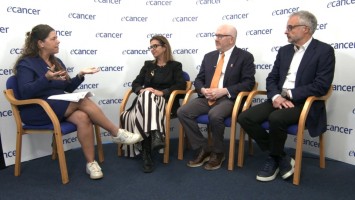4th EUTROC
Sub-typing ovarian cancer
Dr Charles Gourley – University of Edinburgh Cancer Research Centre, UK
A lot of studies in the past have looked at ovarian cancer as one big disease whereas we now realise that it’s at least five different diseases based on the histology and the histology is what the pathologist sees when he or she looks down the microscope. So really in order for the biomarkers to be true biomarkers to predict what drug a patient should get, the analysis has to be done within a specific subtype of ovarian cancer and not taking ovarian cancer as a whole because if you take ovarian cancer as a whole, you can pull out markers that are just associated with a sub-type rather than markers that are associated with response within that sub-type. So that’s one of the reasons, another reason is that in ovarian cancer the first line treatment, certainly in high grade serous ovarian cancer, the first line treatment is very effective so in order to suggest that you’re going to do something other than give her standard first line treatment, then you have to have a very good test. It’s slightly different in relapsed disease, that’s when the cancer comes back. In that situation it’s more of a problem of tumour heterogeneity and whether the tumour that was originally cut out still represents the tumour that has now come back in the patient’s body.
Is there a move towards personalised medicine in this field?
Yes and there’s been a huge amount of discussion about that at this meeting. It’s quite difficult because, as a clinician who does clinical trials, it’s difficult to imagine having an individual genetic sequence from a patient and then being able to somehow put that into a trial with a number of patients. Because in order to get an answer from a trial you need a lot of patients so it may mean that we’ve got to change the way we think about trials, we may have to stop thinking about ovarian cancer trials and endometrial cancer trials and rather just look at the genetics. Certainly, that’s probably a wee bit off as yet but that’s the sort of thing we’re thinking about. It’s not even just variation between patients and trying to get down to the right treatment according to the genetics for that patient, it’s also variation within that individual patient where one bit of their tumour at one site will have mutations in some genes and a bit of tumour in another site will have mutations of other genes. So what we are realising is it’s increasingly complex and it’s not very clear how we’re going to deal with these complexities.
Have there been any promising trials or new agents recently?
In ovarian cancer I would say not particularly. Not within the context of clinical trials, not recently. I’m thinking more of the first line setting; what’s very true is to say that a lot of new trials of new agents in patients whose cancer has come back, a lot of those studies are being done in patients who have got a specific biomarker. That’s because the new agent that comes through is proposed to work in a particular fashion and so the trial has chosen to use particular patients with a particular biology. So they’re being used up front but when you’re asking about whether there’s a trial that has shown a particular biomarker is useful in the context of what we call a big phase III study then there aren’t any of those that have appeared recently, no.
I guess there’s one other thing I’d like to say and I guess the only thing is that one thing that may become important in the future is BRCA1 and BRCA2 mutation status in high grade serous ovarian cancer. We have got agents now which appear to work well in those patients. Again, they’ve not made it all the way through the drug pipeline yet but it will be very interesting to see whether we start selecting patients for particular therapies based on their BRCA1 and BRCA2 mutation status.








